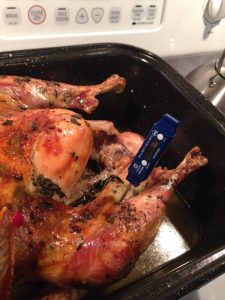I’ve written before that Thanksgiving is my favorite holiday. A mid-week day off (which often stretches to a whole week of food, football and hanging out) is the way to go.
My parents make their annual pilgrimage from Southern Ontario to take in the whole turkey week Black Friday festivities as well.
The week also provides a really great opportunity to take food safety pictures (right, exactly as shown) and talk food safety stuff. The yearly blitz of holiday interviews have started – and so has Dr. Bob, suburban Chicago columnist.

A valiant effort at tackling food safety in the holidays, Dr. Bob misses the mark with a few things:
He starts with,
Emergency rooms across the state and nation are gearing up for a busy week following the Thanksgiving holiday. Unfortunately, many family get-togethers will spread more misery than joy. And I am not speaking of those troublesome individuals that exist in all families that drive many of us to contemplate violent acts. Rather, I am alluding to seasonal foodborne illnesses, which will put a quick end to the Thanksgiving holiday for tens of thousands of families nationwide and several hundred here in our own state.
That’s a great lede – but show your work here Dr. Bob, tens of thousands of hospitalizations might be an over reach here – even if we evenly divide the estimated 128,000 hospitalizations a year we get to a weekly average of 2,500 – I don’t think there’s data to show that Thanksgiving is a 5x or 10x riskier time of the year.
More from the good doctor,
Foodborne illnesses fall into two general categories: intoxication and infection. Foodborne intoxication is caused by ingestion of foods that contain a toxin that may be naturally present in the food, introduced by contamination with poisonous chemicals, or produced by bacteria or fungi growing on foods. Toxins may also be present in some fish and shellfish that have consumed toxin-producing algae. Examples can include contamination with cleaning agents, pesticides and herbicides as well as heavy metals.
Uh, I’m a bit lost – are we talking food borne illness or other stuff now.
Here’s the best though,
It is a well-accepted fact that 100 percent of poultry products are contaminated with salmonella. You read right, 100 percent of the Thanksgiving turkeys carry salmonella. It is only the cooking to proper temperatures and the avoidance of cross contamination that stands between health and sickness.
Not quite, FSIS actually does a great job in reporting contamination levels of Salmonella in poultry, and shows that in turkey contamination is much lower (like only 1.7% positive in turkey). And campy is around the same.
I’m all for talking about food safety and risk reduction and using the holidays as a hook – but lets get the numbers right, avoid the fake news, and give people real risk information.
